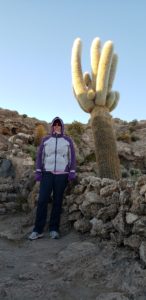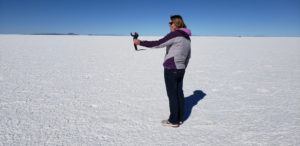 Driving through Salar de Uyuni in the dark, I felt like I was at home on the prairies, driving down a gravel road in the middle of January. The salt looked exactly like snow in the glow of the headlights.
Driving through Salar de Uyuni in the dark, I felt like I was at home on the prairies, driving down a gravel road in the middle of January. The salt looked exactly like snow in the glow of the headlights.
We climbed to the top of Isla Incahuasi to watch the sunrise, and as the sky began to brighten, it truly felt like we were on an island. In the dim pre-dawn light, the salt seemed like a lake surrounding us.

As the sun rose over the horizon, the Salar appeared more like Arctic tundra, and again I felt right at home. It reminded me a lot of frozen Lake Winnipeg in the depths of winter. Even the below-zero temperature added to that feeling. After a chilly breakfast at Isla Incahuasi, we continued to explore different aspects of Salar de Uyuni.
There are many cacti on Isla Incahuasi. Cacti grow only one centimetre per year, so many of them were obviously hundreds of years old. We stopped at an area that looked like a combination of beach and hot springs, although the water is actually cold. Salt minerals (such as iron, copper, sulphur, zinc and lithium) react with the water and cause gas to rise to the ground surface, making the water bubble.
We also saw a spot where salt was being harvested for sale. The salt flats are approximately 40 metres thick so it’s unlikely salt will run out anytime soon. There were other areas that reminded me of the ice on the Red River breaking up in the spring.
The town of Uyuni used to be a railroad town, and that history was evident as we walked around town. It reminds me a bit of an old west town. I half expected a gunfight to break out at any moment. (Fortunately, one didn’t.)
And, of course, we had a lot of fun taking silly photos on the salt flats.









